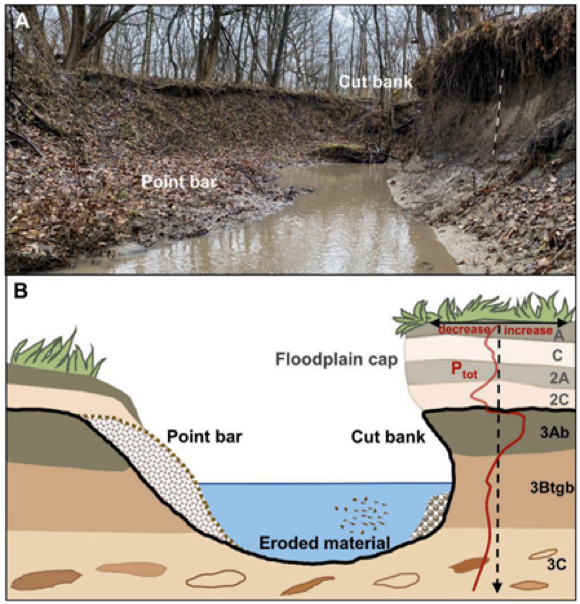Research Themes
Nutrient (nitrogen, phosphorus and other nutrients) cycling in the agroecosystem is a critical determinant for both agricultural production and environmental sustainability. Due to fertilizing and other farming management activities, nutrient cycling in the agroecosystem is more heavily intervened than any natural ecosystems. Improved mechanistic understanding and modeling capability of nutrient cycling under different environmental and management conditions will help develop better fertilizer application strategies and other management strategies for soil health, climate change adaptation/mitigation, and sustainable development.
Core Faculty and Researchers
Andrew Margenot, Wendy Yang, Evan DeLucia, DK Lee, Kaiyu Guan, Bin Peng
Representative Projects
Quantifying Midwest cover crop impacts on crop yield and environmental sustainability (funded by USDA NIFA)
 Team Members: Kaiyu Guan, Bin Peng, Andrew Margenot, Jonathan Coppess, Gary Schnitkey
Team Members: Kaiyu Guan, Bin Peng, Andrew Margenot, Jonathan Coppess, Gary Schnitkey
The intensive corn-soybean rotation system in the U.S. Midwest faces increasing risks in maintaining high crop yield and environmental sustainability, especially under a changing climate and management intensification. Cover crops have been proposed as a straightforward and promising adaptation to fit in the current system in the U.S. Midwest and increase its resilience and sustainability. However, the current state of cover crop knowledge remains limited and localized, and adoption by farmers has been slow. Quantifying these outcomes across different environments and practices remains a major challenge. This project uses a comprehensive and integrated approach to assess cover crops at commercial farmlands for the central Corn Belt by combining airborne-satellite sensing, agroecosystem modeling, and economic analysis. Data collected from multi-scale airborne-satellite sensing (including airborne hyperspectral sensing and satellite fusion data) and field plant and soil samples will be used to implement and validate a process-based model (Ecosys) at the field level. We will then assess optimal management strategies of growing cover crops in the current corn-soybean rotation system, from three management aspects (cover crop types, planting time, termination time) in current climate conditions and future climate scenarios, for the three major Corn-Belt states (i.e. Illinois, Iowa and Indiana). We will conduct further economic analysis of cover crop adoption, incorporating different scenarios of crop insurance and emerging carbon market payment.
Improving the N rate calculator and MRTN for Illinois farmers (Illinois Nutrient Research & Education Council)
 Team members:
Kaiyu Guan, Bin Peng, Sheng Wang
Team members:
Kaiyu Guan, Bin Peng, Sheng Wang
Recommendations on the optimal nitrogen rate can help farmers reduce the fertilizer cost while maintaining the high productivity, thus maximizing net economic returns and reducing nutrient loss. This project aims to maximize the NREC historical and current investment in N rate database development in order to better serve Illinois farmers in nutrient management. This project will compile the most comprehensive NREC N trial database and use the database to upgrade the MRTN calculator. The project will also develop a next generation MRTN calculator based on observation-constrained model simulations. The project will finally develop a web-based platform for both the upgraded and next-generation MRTN calculators to serve Illinois farmers and provide training, outreach, and education to farmers. Check the on-line tool at https://harvest.ncsa.illinois.edu/nitrogen-advisor.
Co-Producing Community – An integrated approach to building smart and connected nutrient management communities in the U.S. Corn Belt (funded by NSF)
 Team members: Andrew Margenot, McKenzie Johnson, Kaiyu Guan, Bin Peng
Team members: Andrew Margenot, McKenzie Johnson, Kaiyu Guan, Bin Peng
The U.S. Corn Belt produces about 30% of the world’s corn and soybean, which depends on the use of fertilizers containing both nitrogen (N) and phosphorus (P). However, heavy fertilizing directly affects farmers in terms of expenses and threatens valuable natural resources. Yet, farmers’ perceptions of nutrient management challenges vary widely as does their willingness to adopt novel nutrient management approaches. Thus, an urgent unmet need exists to provide farmers with and help them adopt effective and trusted nutrient management tools that are informed by advanced science and technology as well as by farmer-based practical expertise. This project addresses these needs by developing a smart and connected “Nutrient Management Community” (NuMC) in rural farming communities in the U.S. Corn Belt. Specifically, we will take an integrated approach using farmer-researcher-farmer knowledge transfers to co-produce an NuMC. Our primary goal is to develop science-driven recommendations on N and P management that can be tailored to different farmers’ needs.
A missing piece of the Illinois phosphorus puzzle: quantifying statewide streambank erosion to inform effective nutrient loss reduction strategy (funded by NREC)
 Team members: Andrew Margenot, Shengnan Zhou, Bruce L Rhoads, Sheng Wang, Kaiyu Guan
Team members: Andrew Margenot, Shengnan Zhou, Bruce L Rhoads, Sheng Wang, Kaiyu Guan
Phosphorus (P) loss through streambank erosion can contribute to up to one-third of total riverine P export (e.g., Iowa). However, the contribution of this overlooked non-point source P losses in Illinois remains unknown. Quantifying streambank erosion –where and how much– is necessary to distinguish non-point source P responsiveness to best management practices, which can be used to identify and guide cost‐efficient mitigation strategies. This project focuses on quantifying non-agricultural sources of P that leach into the Mississippi River, clarifying agricultural P contributions. To achieve this goal, this project uses field data collection, airborne-satellite integrative sensing, and process-based watershed modeling to quantify river bank erosion and P loss. The study will provide much-needed information for a 2025 milestone in the Illinois Nutrient Loss Reduction Strategy to reduce P losses to the Mississippi River and ultimately the Gulf of Mexico.
